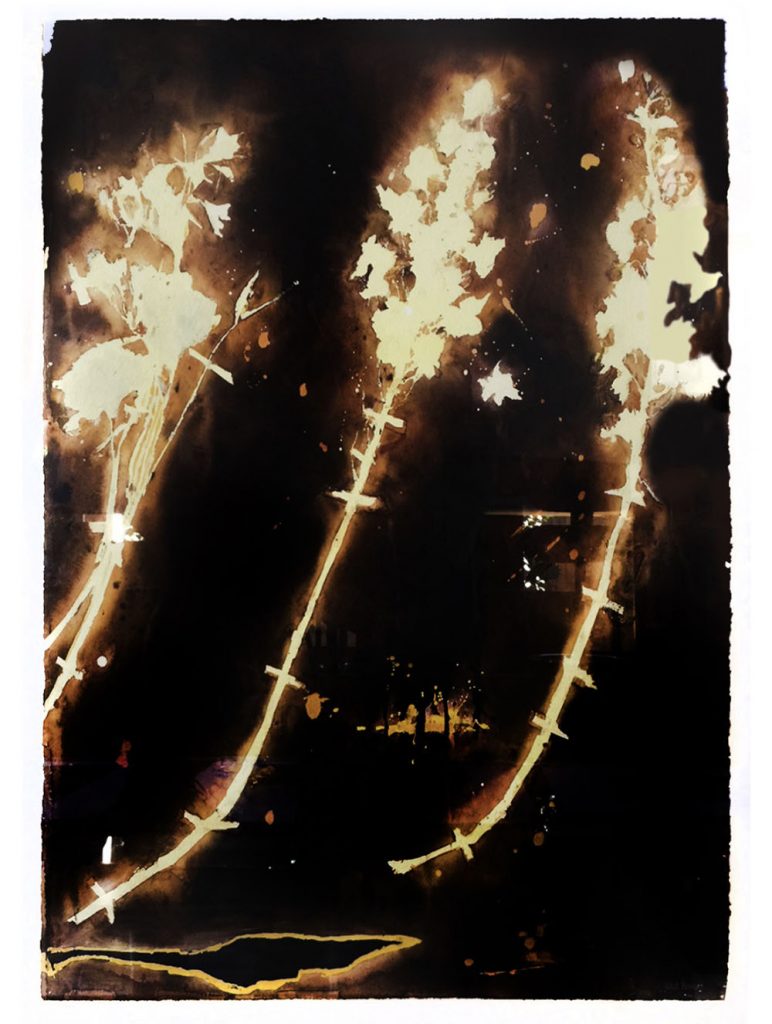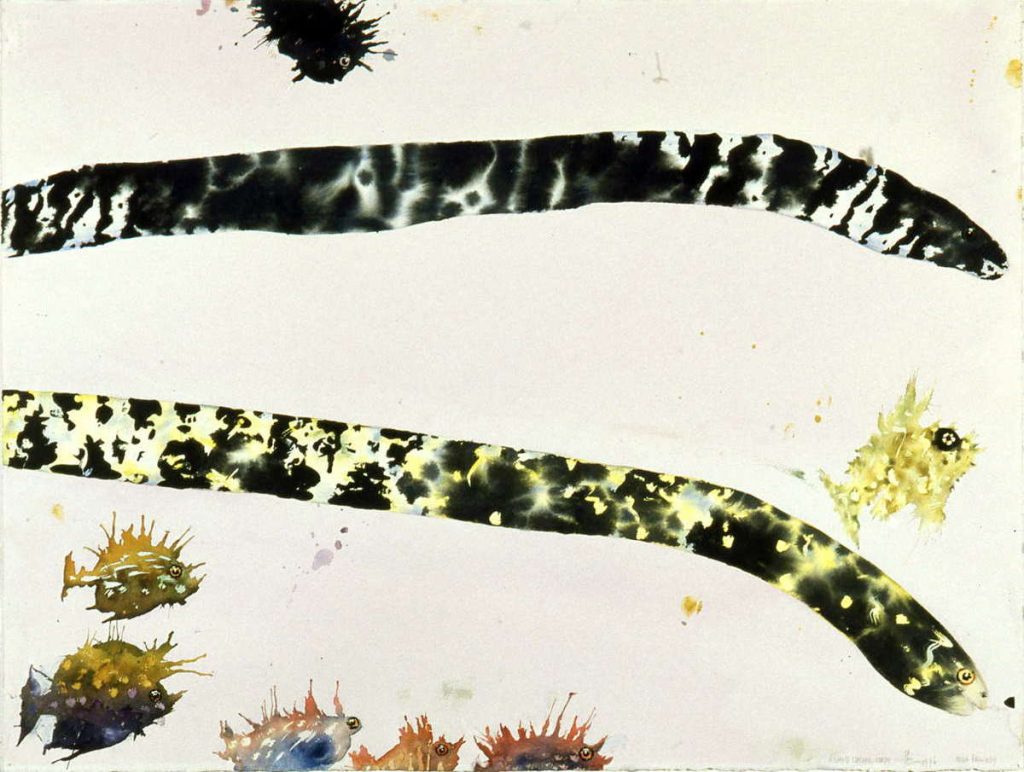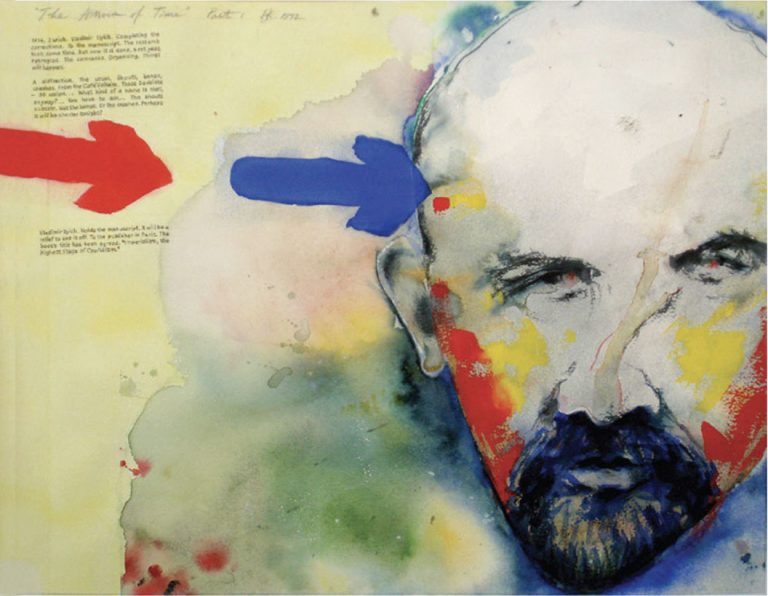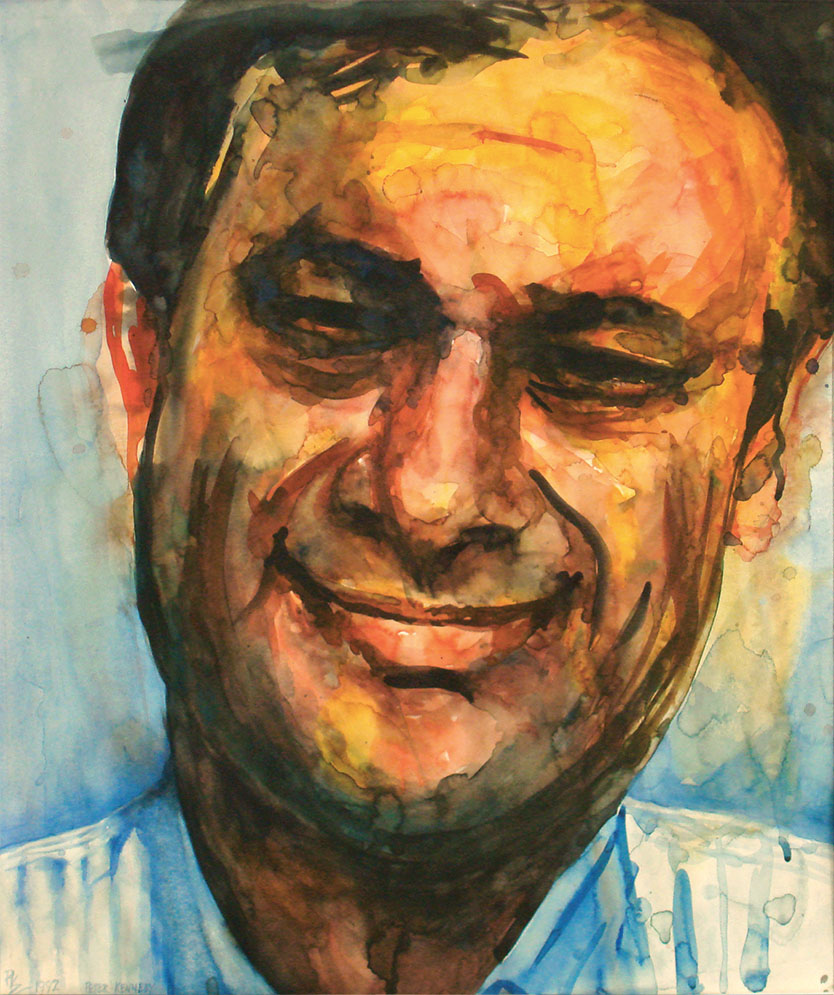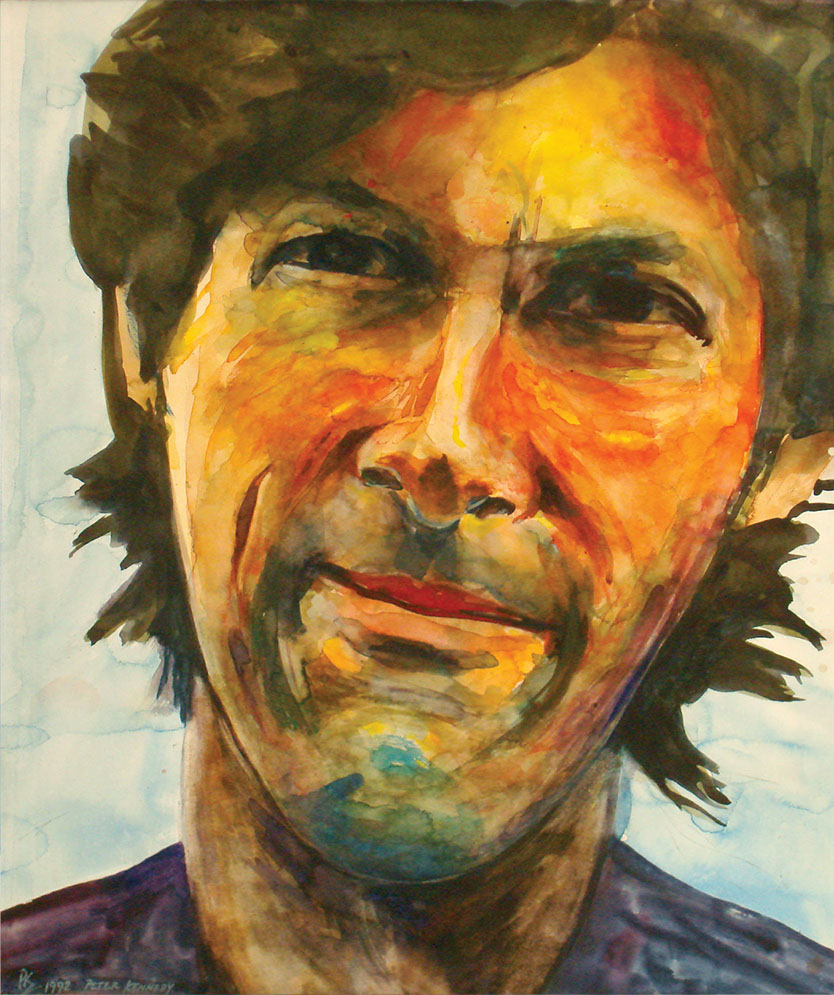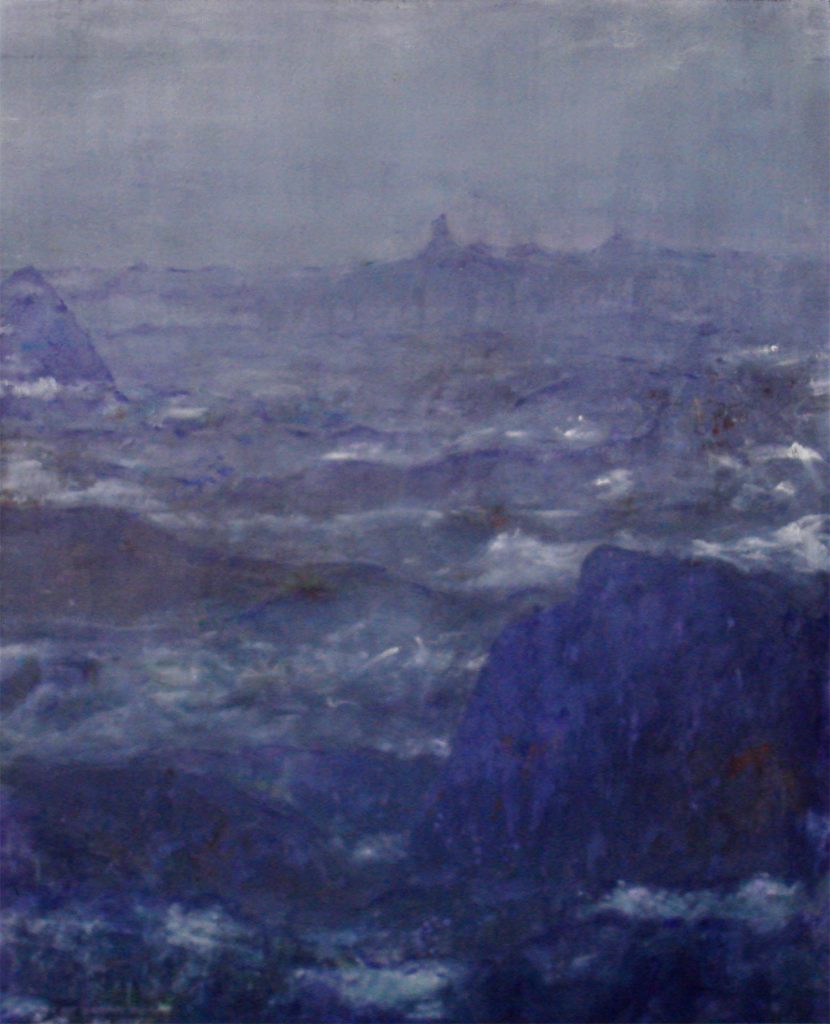Watercolours
Untitled (gum tree) 2008
Watercolour, charcoal, gouache and pastel on paper 113 x 121 cm
Private collection
Untitled (gum tree) 2008
Watercolour, charcoal, gouache and pastel on paper 113 x 128 cm
Private collection
Untitled (gum tree) 2006
Watercolour, charcoal, gouache and pastel on paper
123.5 x 105 cm
Private collection
Selected works from the exhibition ‘Requiem: Choruses from the North and South’ 1996
Watercolour, gouache on paper, 76 x 56.5 cm
Left: Collection of the artist Centre: Private collection Right: Private collection
Selected works from the exhibition ‘Requiem: Choruses from the North and South’ 1996
Watercolour, gouache on paper, 76 x 56.5 cm
Left: Collection of the artist Centre: Private collection Right: Private collection
Above: One of four meditations: Madang paradise birdwing butterfly as luminous presence 1996
Watercolour, gouache, charcoal, acetate on paper 56.3 x 75.5 cm
Collection of the artist
Madang Nature Studies
February, 1996. Artist / participant, Madang, Papua New Guinea. Attached to a Madang based scientific research facility as an Earthwatch Fellow.The project: a collaboration between scientists and local villagers to propagate the rare Madang Birdwing Butterfly as a commercial venture designed to generate income and improve the living conditions of the villagers whose land is also the Birdwings’ unique habitat. It is a story of underdevelopment; those in the Global South look to the North for a solution to their impoverishment. The scheme would connect indigenous people to the wealthy butterfly collectors of Europe and North America.
During the time spent on site it became apparent just how rare the Madang Birdwing Butterfly was. Never sighted – by anyone – extant or not, its lack of a visible presence was conceptualised as a ghostly absence in four watercolours.
Meanwhile, absence did not apply to other life. Countless species thrive in the tropical conditions: fishes, insects, moths, even butterflies – everything proliferated in abundance.
Absurd taxonomy 2 1996
Watercolour, pencil on paper 56.3 x 75.5 cm
Private collection
Selected works from AJK at the Wall of Ghosts 1995
Ghost (as if laid to rest) 2
Watercolour on paper 75.5 x 56.5 cm
Collection of the artist
AJK at the Wall of Ghosts
A J K is my son. The ghosts, revolutionary modernists of the twentieth century: Marx, Lenin, Stalin, Mao. The wall is the Berlin Wall. It split the city and its people into two parts – the East (socialism) and the West (capitalism). Profoundly symbolic, it reminded the world of the threat these ideologies posed were their differences militarised in a superpower, global conflict. The Berlin Wall fell in 1989. The Soviet Union followed in 1991 – bringing to an end the Cold War; the threat of global conflict, the tensions and anxieties, gone too.
A J K, born in the mid-1990s, began life in a less threatening world. But it was not to last. Islamic terrorism and intractable wars were to follow in the first decades of a new century. It is in the nature of ghosts to return and that can be said of the ghosts in this work – the frequency of their returns having the appearance of being continuous although, today, their allure has faded. Once emanations that dazzled, the judgements of history have taken their toll. But one of them, the oldest (Marx), can help when it comes to the problems of the twenty-first century: that is when ‘the market has no answer and economic and political liberalism has no solution.’*
* Eric Hobsbawn “How to Change the World – Tales of Marx and Marxism” Little, Brown 2011
Rain forest, in close up, with drumming sound (lyre bird) 1994
Ink, gouache, collaged paper, tape, 48 x 133 cm
Private collection
First world, third world 1992
Watercolour on paper 76 x 56.5 cm
Collection of the artist
The Arrow of Time – Triptych 1992
Private collection
Note: The texts in Parts 1 & 2 are reproduced below. A background to the work is also provided.
The Arrow of Time – Part 1
1916, Zurich. Vladimir Ilyich. Completing the corrections. To the manuscript. The research took some time. But now it is done. Next year, Petrograd. The comrades. Organising. Things will happen. A distraction. The usual. Shouts, bangs, crashes. From the Café Voltaire. Those Dadaists – so called. … What kind of a name is that, anyway?… You have to ask… The shouts subside. Not the bangs. Or the crashes. Perhaps it will be shorter tonight? Vladimir Ilyich. Holds the manuscript. It will be a relief to see it off. To the publisher in Paris. The book’s title has been agreed: “Imperialism, the Highest Stage of Capitalism.”The Arrow of Time – Part 2
1991, Moscow, December 25. Vladimir Ilyich is turning over. It’s been sixty-seven years. And now he’s moving. In the blackness. In the silence. Of his mausoleum. And. In the many graves beyond there is the same movement. Some who are turning Vladimir Ilyich knew at the time.The Arrow of Time Parts 1 & 2 and Shock News (December 25, 1991)
Background
This work is about time and history. It is about the transit of ideas and the fate that becomes them. It is a lament for the failed hopes and dreams of a revolutionary generation who had hoped to change the world – but didn’t.
The time is Christmas day 1991. And the Soviet Union collapses – signalling the end of the Cold War. This work was my immediate response to that event – an event to which I felt a strong connection. Since the year of my birth (1945) the confrontation between capitalism and socialism, and with it the threat of nuclear annihilation, had been an ominous reality.
A junior partner with the US in Cold War conflicts, Australia fought alongside the US in Korea and Vietnam. The reality of this relationship during the Cold War – the tension implicit in it – meant that Australia could not be neutral in the event of a nuclear war. (It is an alliance with a long history. Australia assumes that the US will protect Australia should that be required. It is an assumption that has never been tested. Australia, in return, has always been a willing partner in US foreign military interventions).
The events of both Christmas day 1991 and earlier, the collapse of the Berlin wall in 1989, signalled to many in the West, the triumph of capitalism and ideological supremacy. With socialism swept aside, the brake on capitalism’s assault on human and natural resources would expand and continue uncontested in the name of a free market and economic growth.
The Work
An earlier example of my use of words in an artwork, the intention is to tell a story, to extend the visual experience and expand ways of “seeing”. At the time the work was an experiment. It now stands as a precursor to subsequent work where words and sentences are visually integrated.
Parts 1 & 2 has Lenin as its central character.
Part 1 (left panel)
The story begins in 1916. Lenin is in exile in Zurich. He dreams of changing the world and works to that end. The Dadaists are also in Zurich, in the same street as Lenin, meeting, and performing at the Café Voltaire. They too dream; they dream of changing the world of art through art as avant-garde action. At this moment the arrow of time passes across art and politics. The respective histories gain momentum, become dynamic, driven by ideas.
In 1917 Lenin returns to Russia to lead the revolution.
Part 2 (middle panel)
Christmas day, 1991: Lenin, learning that socialism has succumbed to capitalism’s transformative force, turns in his Moscow tomb. His revolutionary comrades turn too, in their lost and scattered graves. The mass turning is audible. A dirge. A character in its own right, the arrow of time, sensitive to change and its destabilising effect, proceeds erratically.
Shock News (December 25,1991) (right panel)
This panel refers to Francis Fukuyama’s interpretation of these events as “the end of history”. I interpret this as meaning the end of ideology- an idea suited to Capitalism’s interests.
Also here, is an ironic use of contemporary street argot- “CAPITALISM RULES, OK” – an allusion to post-Cold War triumphalism in the West – a sentiment deeply felt and promoted by the US.
Once again the arrow’s course is straight… for the time being.
Peter Kennedy, December 2020
This is one of many works on the same subject. Some of these works are quite small and others are on a large scale. Most have not been exhibited. Those that have include Chorus: from the Breath of Wings, a major exhibition at Heide Museum of Modern Art, 1993. (See Installation / Sound / Performance section of this website, and for the drawings… ‘And And And’, ‘Anthemic Map’, ‘All that is Solid’, 1992, refer to Works on Paper section)
Three watercolour portraits of friends painted from snapshots taken in 1992













